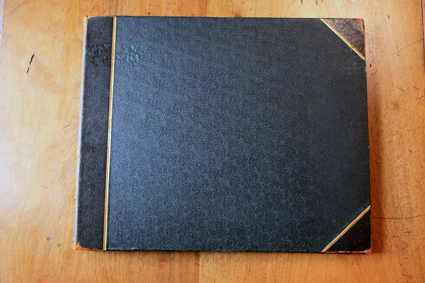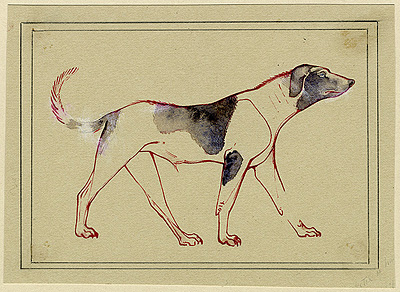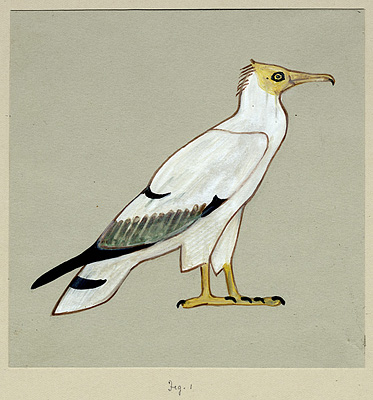
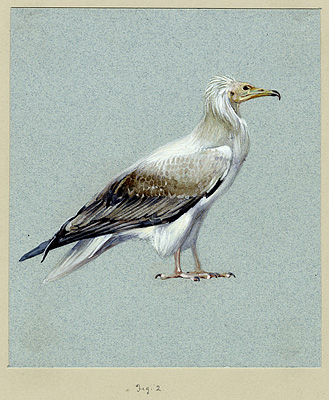 Carter MSS. vii.1.1b.1
Carter MSS. vii.1.1b.1
watercolour, 12.5 by 12.6 cm
Location and dating: Maidûm, tomb of Nefermaet and Itet, chapel of wife
Itet, temp. Snefru (4th Dynasty), now in Cairo, Egyptian Museum
Topographical Bibliography: iv.93
Previous reproductions: ILN Christmas 1944, fig. on 34 [top left];
Reeves, N. and Taylor, J. H. Howard Carter before Tutankhamun (1992), fig. on 44 [upper];
Winstone, H. V. F. Howard Carter and the Discovery of the Tomb of Tutankhamun (2006), 2nd col. pl. between pp. 128-9 [upper left];
Malek, J. (ed.), Egypt (1993), fig. on 36 [upper right];
id. The Treasures of Tutankhamun (2006), fig. on 25 [enclosure TUT.25.08_B [upper]];
id. in Ancient Egypt 8 [5] (April/May 2008), fig. on 39 [top right].
Carter MSS. vii.1.1b.2
watercolour, 13.3 by 15.3 cm
Previous reproductions: ILN Christmas 1944, fig. on 34 [top right];
Reeves, N. and Taylor, J. H. Howard Carter before Tutankhamun (1992), fig. on 44 [lower];
Winstone, H. V. F. Howard Carter and the Discovery of the Tomb of Tutankhamun (2006), 2nd col. pl. between pp. 128-9 [upper right];
Malek, J. (ed.), Egypt (1993), fig. on 36 [lower right];
id. in Ancient Egypt 8 [5] (April/May 2008), fig. on 39 [top left];
id. The Treasures of Tutankhamun (2006), fig. on 25 [enclosure TUT.25.08_B [lower]].
Egyptian Vulture, Neophron percnopterus percnopterus
Representations of the Egyptian Vulture occur frequently in Egyptian script,
since the depiction of this bird was used to denote the 'aleph' hieroglyph
(G1 of Gardiner's sign-list). Its attestations in Egyptian art are,
however, extremely rare and it was never linked to any deity. In fact,
there is only one possible example of the Egyptian Vulture shown in a
natural setting, though in a very unlikely situation. In the Theban tomb of
Senemioh (TT 127) this bird is represented perching on top of a papyrus
umbel. In hieroglyphs, the Egyptian Vulture is depicted in a very detailed
and accurate way: with its characteristic white or pale plumage, hooked
bill, bare skin on the head, the occipital ruff, etc. This phenomenon,
together with preserved remains or mummies, testifies the
constant presence of this species in Egypt. The bird also occurs as the
so-called 'Pharaoh's hen' in accounts of early travellers. Presently, the
Egyptian Vulture breeds in parts of Southern Europe, the Middle East, Asia and
North Africa, and winters in Southern Asia, parts of the Middle East and
mainly sub-Saharan Africa. In Egypt it still occurs as a breeding
resident in small numbers in the South-East and Upper Nile Valley but can
be seen more widely outside the breeding season and especially during migration
periods in autumn and spring when the European population is passing through.
(Jiří Janák and John Wyatt)
The species is certainly an Egyptian Vulture in spite of the leg colour
being yellow (as in the hieroglyph) rather than pink (as in the real bird).
Carter's painting of the real bird is of a sub-adult rather than adult
but he nevertheless catches all the salient points including the pink feet.
The colour pink did not exist in the Old Kingdom palette hence the use of
yellow instead. (John Wyatt)
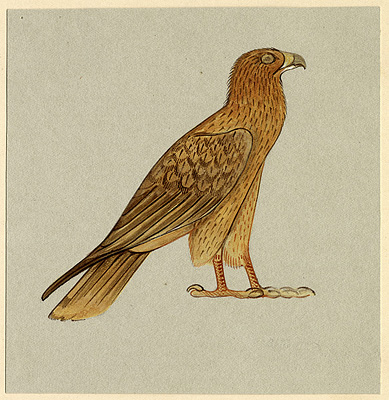
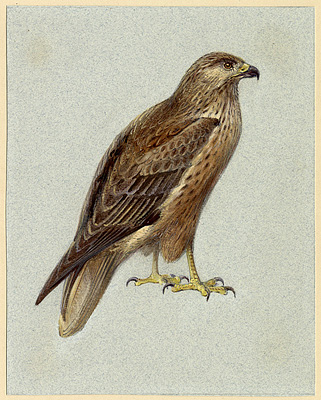 Carter MSS. vii.1.2.1
Carter MSS. vii.1.2.1
watercolour, 13.4 by 14.1 cm
Location and dating: mortuary temple of Queen Hatshepsut at Deir el-Bahri,
temp. Hatshepsut (Dyn. 18)
Previous reproductions: Griffith, F. L. A Collection of
Hieroglyphs (1898), 19 pl. i [1]; ILN Christmas 1944, fig. on 34
[middle left]; Winstone, H. V. F. Howard Carter and the discovery of the
tomb of Tutankhamun (2006), 3rd col. pl. between pp. 128-9 [upper left];
Malek, J. in Ancient Egypt 8 [5] (April/May 2008), fig. on 38 [lower right].
Carter MSS. vii.1.2.2
watercolour, 14.5 by 18.4 cm
Previous reproductions: ILN Christmas 1944, fig. on 34 [middle right];
Winstone, H. V. F. Howard Carter and the discovery of the tomb of Tutankhamun (2006), 3rd col. pl. between pp. 128-9 [upper right];
Malek, J. in Ancient Egypt 8 [5] (April/May 2008), fig. on 38 [lower left].
Long-legged Buzzard, Buteo rufinus cirtensis (resident race) and
Buteo rufinus rufinus (migratory race and scarce winter visitor)
A schematic representation probably of the Long-legged Buzzard stood for the
hieroglyph tjw (G 4 of Gardiner's sign-list) in Egyptian script.
The presence of the Long-legged Buzzard is also attested by mummified
remains identified among birds that were buried in animal necropoli of the
Graeco-Roman Period. These birds count among the breeding residents of modern
Egypt (race cirtensis, mainly in the Eastern Desert and mountains) but
race rufinus is also a scarce passage migrant and winter visitor and
then seen more widely. (Jiří Janák and John Wyatt)
I have not seen the original hieroglyph so cannot tell how accurate Carter's
copy is. This has been identified as the rusty form of the Long-legged
Buzzard but lacks the pale cream-buff head and breast, dark belly and
pale rufous unbarred tail of that form. The painting is just too red
overall. Carter's actual bird is closer to the hieroglyph although the pale
head is still missing. There are also at least two other actual species
which could be the hieroglyph. I am still to be convinced that Long-Legged
Buzzard is the correct identification. (John Wyatt)
|
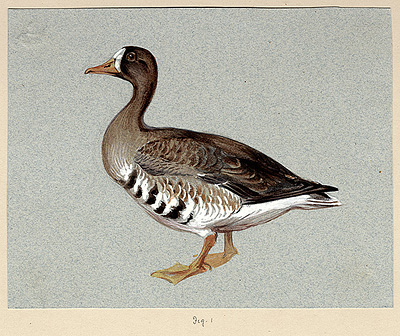
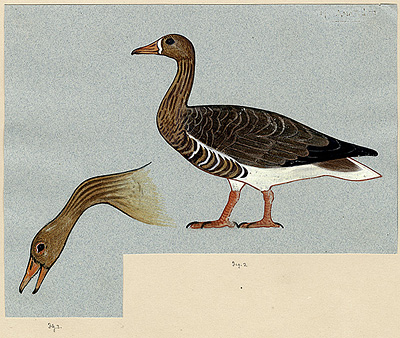 Carter MSS. vii.1.3.1
Carter MSS. vii.1.3.1
watercolour, 17.7 by 13.7 cm
Previous reproductions: ILN Christmas 1944, fig. on 33 [top right].
Carter MSS. vii.1.3.2
watercolour, 23.5 by 14.8 cm
Location and dating: Maidûm, tomb of Nefermaet and Itet, chapel of
wife Itet, temp. Snefru (4th Dynasty), now in Cairo, Egyptian Museum
Topographical Bibliography: iv.93-4
Previous reproductions: ILN Christmas 1944, fig. on 33 [top left].
Carter MSS. vii.1.3.3
watercolour, 23.5 by 18.6 cm
Location and dating: Maidûm, tomb of Nefermaet and Itet, chapel of
wife Itet, temp. Snefru (4th Dynasty), now in Cairo, Egyptian Museum
Topographical Bibliography: iv.93-4
Previous reproductions: ILN Christmas 1944, fig. on 33 [top left].
Greater White-fronted Goose, Anser albifrons albifrons, and
Greylag Goose, Anser anser
The gb sign (G 38 of Gardiner's sign-list) has been believed to depict
schematically the Greater White-fronted Goose, the avian manifestation of
the Earth god Geb. Scholars, however, still dispute this identification. These geese also occur among
Egyptian images of domestic birds, wildfowling scenes and food offerings. An
elaborate image of the Greater White-fronted Goose is attested in the famous 'Geese
of Maidûm' scene. This comes from the mastaba of Itet (temp. Snefru, 4th Dynasty) and
the bird was depicted together with two other goose-types: the Red-breasted
Goose, Branta ruficollis, and the Greylag Goose, Anser
anser (see below). Skeletal remains of the Greater White-fronted Goose are
recorded from different sites and periods of Egyptian history. In modern
Egypt, these geese are now only rare and irregular winter visitors. (Jiří Janák and John Wyatt)
The first painting is an excellent depiction of the actual species except
that the two feet should be more orange. The pinky bill is correct for the
Russian race which probably was the one which reached Egypt in the past.
The second painting is from the 'Geese of Maidûm'. The whole bird is a
Greater White-fronted Goose although the body is too long, the bars too high
on the underside, the white front too small and the legs not orange enough,
the last a Carter error. This is a copy of one of the birds from the two to
the left of centre of the whole painting. The head and neck copy is part
of the left outside bird. This is not a White-fronted Goose nor the Bean
Goose, Anser fabilis, identified by Houlihan. The bill has no
basal black, which would have been a clear indication, with the orange legs
on the painting, of a Bean Goose but we know from the Egyptian Vulture
hieroglyph from the same tomb that the artist had no pink, so pink instead
of orange legs with this bill would give us a Greylag Goose, Anser anser, instead. (John Wyatt)
|
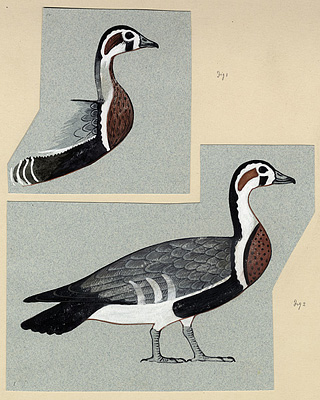
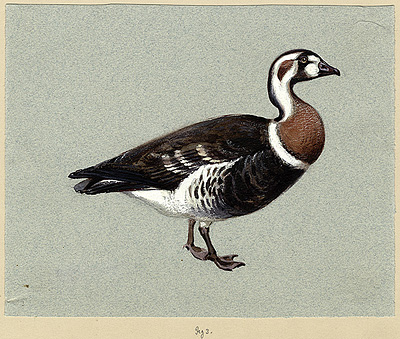 Carter MSS. vii.1.4.1
Carter MSS. vii.1.4.1
watercolour, 9.5 by 10.6 cm
Location and dating: Maidûm, tomb of Nefermaet and Itet, chapel of
wife Itet, temp. Snefru (4th Dynasty), now in Cairo, Egyptian Museum
Topographical Bibliography: iv.93-4
Previous reproductions: none.
Carter MSS. vii.1.4.2
watercolour, 14.1 by 16.6 cm
Location and dating: Maidûm, tomb of Nefermaet and Itet, chapel of
wife Itet, temp. Snefru, now in Cairo, Egyptian Museum
Topographical Bibliography: iv.93-4
Previous reproductions: ILN Christmas 1944, fig. on 33 [bottom right].
Carter MSS. vii.1.4.3
watercolour, 19.3 by 15.4 cm
Previous reproductions: ILN Christmas 1944, fig. on 33 [bottom left];
Malek, J. in Ancient Egypt 8 [5] (April/May 2008), fig. on 38 [upper].
Red-breasted Goose, Branta ruficollis
The elaborate image of two Red-breasted Geese from the famous
'Geese of Maidûm' scene in the mastaba of Itet at Maidûm (4th Dynasty)
belongs among the most frequently debated, celebrated and reproduced masterpieces of
Egyptian art. This depiction of the Red-breasted Goose represents one
of only two pictorial representations of this species known from
ancient Egyptian sources. The other is a headless version from a painted wall
of the Decorated Tomb (No. 100) at Hieraconpolis. The bird is now only a
very rare vagrant to Egypt. (Jiří Janák and John Wyatt)
The first two illustrations are copies of the two birds to the right of centre
of the 'Geese of Maidûm'. They can only be Red-breasted Geese although the
diagnostic broad white flank stripe has been under-emphasized as it also is in
Carter's painting of the actual bird. There are no possible confusion species.
(John Wyatt)
|
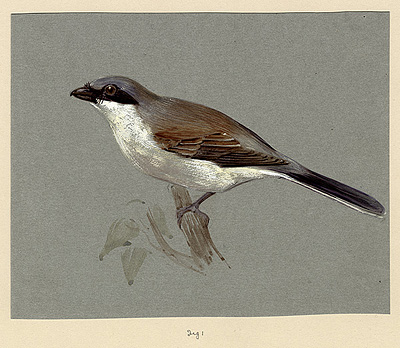
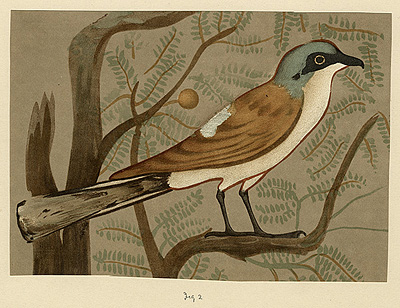
Carter MSS. vii.1.5.1
watercolour, 17.9 by 14.3 cm
Previous reproductions: none.
Carter MSS. vii.1.5.2
watercolour, 19.4 by 13.6 cm
Location and dating:
tomb 3 of Khnumhotep III (or II according to some authors) at Beni Hasan,
temp. Amenemhet II to Sesostris II (Dyn. 12)
Topographical Bibliography: iv.147 (113)
Previous reproductions: none.
Red-Backed Shrike, Lanius collurio collurio
Only a single representation, albeit very skilful and accurate, of the
Red-Backed Shrike has been positively identified to date among ancient
Egyptian depictions of avian species. It comes from the 12th Dynasty tomb
of Khnumhotep III at Beni Hasan, where the bird is shown perched on the
branches of an acacia tree. Such perching on small trees as it looks out
for food is normal behaviour for this bird. The Red-Backed Shrike is
nowadays a common autumn migrant and an irregular winter visitor. It is often found
near water. (Jiří Janák and John Wyatt)
Both versions of the bird indicate that this can only be a male Red-Backed
Shrike in spite of a few discrepancies such as the understatement of the
chestnut back. There are no possible confusion species. (John Wyatt)
|
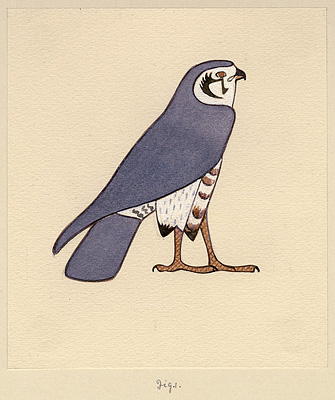
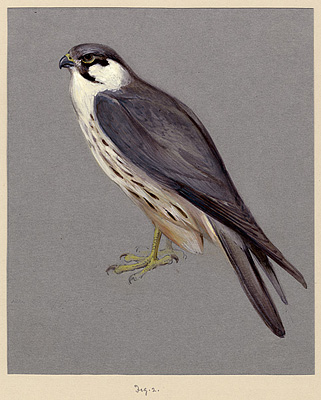 Carter MSS. vii.1.6.1
Carter MSS. vii.1.6.1
watercolour, 12 by 13.5 cm
Location and dating: not known
Previous reproductions: ILN Christmas 1944, fig. on 31 [upper left];
Malek, J. The Treasures of Tutankhamun (2006), fig. on 25 [enclosure TUT.25.08_C [upper left]].
Carter MSS. vii.1.6.2
watercolour, 15.4 by 18.2 cm
Previous reproductions: ILN Christmas 1944, fig. on 31 [upper right];
Malek, J. The Treasures of Tutankhamun (2006), fig. on 25 [enclosure TUT.25.08_C [lower]];
id. in Ancient Egypt 8 [5] (April/May 2008), fig. on 39 [bottom].
Falcon, Falco spp.
The falcon was the iconic bird of ancient Egypt. It was associated
with power, dominance, sky and heavenly bodies, and hence connected with
several gods. Thus, the so-called 'Horus falcon'
belongs among the most frequently depicted birds in ancient Egypt, both in
hieroglyphs and art. Many representations of the bird in different sizes,
shapes and materials are attested from the Late Predynastic Period onwards,
though the earliest identified skeletal remains of this bird are even older.
In the Graeco-Roman period, thousands of falcons were elaborately mummified
and buried in large cemeteries.
Eleven species of falcon have so far been identified from the thousands of
mummified remains from the Graeco-Roman period found in bird cemeteries.
These are the Lesser Kestrel, Falco naumanni, Western Red-footed
Falcon, Falco vespertinus, European Hobby, Falco subbuteo,
Eleonora's Falcon, Falco eleonorae, and Saker, Falco cherrug
(all passage migrants); Sooty Falcon, Falco concolor (summer visitor);
Peregrine, Falco peregrinus and Merlin, Falco columbarius
(both winter visitors); and Common Kestrel, Falco tinnunculus
rapicoliformis, Barbary Falcon, Falco pelegrinoides pelegrinoides
(formerly considered a race of Peregrine), and Lanner, Falco biarmicus
erlangeri (all still resident breeding species). All falcon species
have black moustachial lines beneath the eyes which in Egyptian art,
hieroglyphs and religion represent the Eye of Horus (Wedjat). Their amazing
eyesight, power, dominance and speed have also connected them from very
early times to sky and heavenly bodies, to several gods (e.g. Horus in all
his manifestations, Re, Re-Harakhty, Montu, Sokar, Isis, Nephthys and
others) and, through Horus, to the king. The female Common Kestrel has
specific links to Isis and Nephthys and various species to Sokar and Horus
generally, but Horus the Elder, wearing the double crown, is most probably
a depiction of both the red-naped Barbary Falcon and the white-crowned
Lanner together. (Jiří Janák and John Wyatt)
The hieroglyph depicted by Carter may represent, because of its red leg-feathers,
the European Hobby, Falco subbuteo, but much more accurate examples
of this species from ancient Egypt do exist. The actual bird illustrated is
Peregrine Falcon, Falco peregrinus, but, interestingly, Carter has
depicted a juvenile bird where the stripes run down rather than across the
body as they would in an adult. The painting also shows no sign of any red on the nape
which might have suggested the Barbary Falcone, Falco peregrinoides.
(John Wyatt)
|
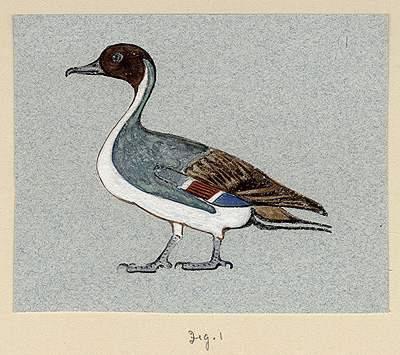
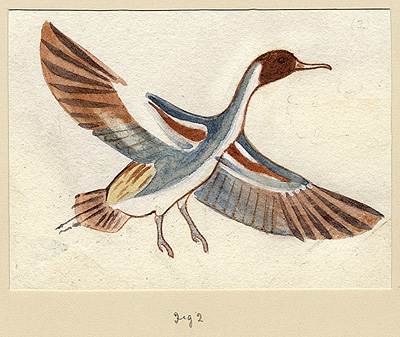
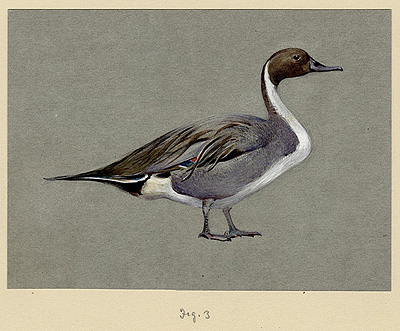
Carter MSS. vii.1.7.1
watercolour, 9.6 by 7.7 cm
Location and dating: not known
Previous reproductions: Griffith, F. L. A Collection of
Hieroglyphs (1898), 22-3 pl. ii [11]; ILN Christmas 1944, fig.
on 33 [middle left]; Malek, J. The Treasures of Tutankhamun (2006),
fig. on 25 [enclosure TUT.25.08_A [top]].
Carter MSS. vii.1.7.2
watercolour, 11.3 by 8.2 cm
Location and dating: not known
Previous reproductions: Malek, J. The Treasures of Tutankhamun
(2006), fig. on 25 [enclosure TUT.25.08_A [middle]].
Carter MSS. vii.1.7.3
watercolour, 12.4 by 9 cm
Previous reproductions: ILN Christmas 1944, fig. on 33 [middle right];
Malek, J. The Treasures of Tutankhamun (2006), fig. on 25
[enclosure TUT.25.08_A [bottom]].
Northern Pintail, Anas acuta acuta
Representations of the Northern Pintail are very common both in Egyptian
script in the form of the s3 sign (G 39 of Gardiner's sign-list) and in
Egyptian art among representations of waterfowl. It was depicted in the
wild, being trapped, as well as in aviaries, and also being killed or among
foodstuff and food offerings. These ducks in flight were even pictured on
tomb ceilings and palace floors. Moreover, there are many attestations
for the Northern Pintail's skeletal remains from the Predynastic Period
onwards. As for modern Egypt, this bird has always been a common passage
migrant and winter visitor to the country. (Jiří Janák and John Wyatt)
All three figures clearly indicate the male Pintail Duck. There are no confusion species. (John Wyatt)
|
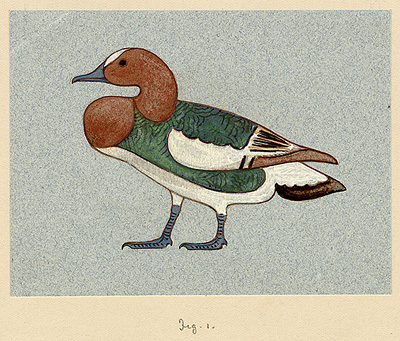
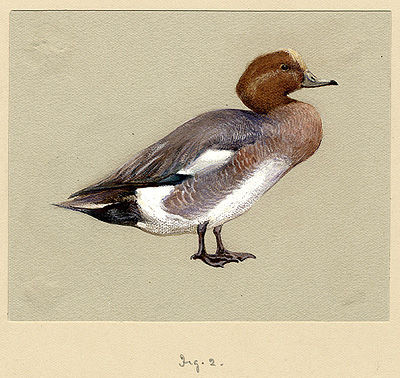 Carter MSS. vii.1.8.1
Carter MSS. vii.1.8.1
watercolour, 11.9 by 8.9 cm
Location and dating: tomb 3 of Khnumhotep III (or II according
to some authors) at Beni Hasan, temp. Amenemhet II to Sesostris II (Dyn. 12)
Topographical Bibliography: iv.147 (14)
Previous reproductions: ILN Christmas 1944, fig. on 32 [top left];
Malek, J. in Ancient Egypt 8 [5] (April/May 2008), fig. on 39 [middle right].
Carter MSS. vii.1.8.2
watercolour, 11.3 by 9.2 cm
Previous reproductions: ILN Christmas 1944, fig. on 32 [top right];
Malek, J. in Ancient Egypt 8 [5] (April/May 2008), fig. on 39 [middle left].
European Wigeon, Anas penelope
The European Wigeon was one of many duck types that were bred and eaten in
ancient Egypt. Its hieroglyphic representation even stood for the words
'food' or 'foodstuff' (df3, Gardiner's sign-list G 42). This bird was
identified both among depictions of food offerings (e.g. in the 12th Dynasty
tomb of Khnumhotep III at Beni Hasan) and among skeletal remains of avian
species from different periods of Egyptian history (from the Predynastic to
the Late Period). The bird breeds in northern Eurasia and winters in
Western Europe, the Middle East and North Africa. It is a common
passage migrant and winter visitor to most of Egypt's inland waters.
(Jiří Janák and John Wyatt)
The hieroglyph shows a drake Wigeon. The crown should be golden, not white,
and the body colour grey, not green, but the presence of a crown stripe and
the broad white wing bar both indicate that this can only be a Wigeon. The
shape and wing bar also points to that being a Wigeon. Carter's painting of
an actual bird is very good and clearly captures both the diagnostic
shape and white wing bar of this species. (John Wyatt)
|
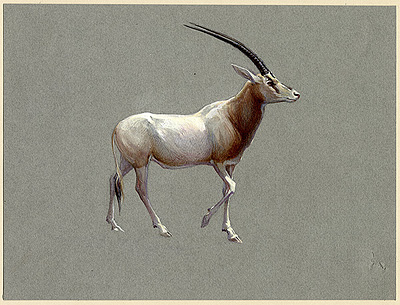
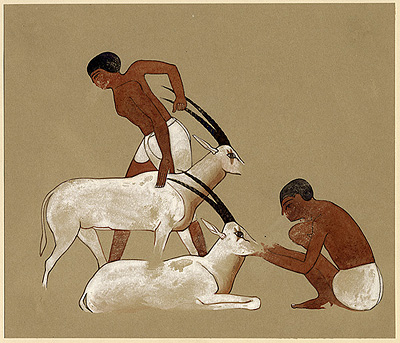 Carter MSS. vii.1.9.1
Carter MSS. vii.1.9.1
watercolour, 20.1 by 15.2 cm
Previous reproductions: ILN Christmas 1944, fig. on 32 [middle right];
Egyptian Archaeology 22 (2003), fig. on 2 [lower left];
Winstone, H. V. F. Howard Carter and the discovery of the tomb of
Tutankhamun (2006), 3rd col. pl. between pp. 128-9 [lower left].
Carter MSS. vii.1.9.2
watercolour, 23.2 by 19.9 cm
Location and dating: tomb 3 of Khnumhotep III (or II acording to
some authors) at Beni Hasan, temp. Amenemhet II to Sesostris II (Dyn. 12)
Topographical Bibliography: iv.145-6 (7)-(11)
Previous reproductions: ILN Christmas 1944, fig. on 32 [middle left];
Egyptian Archaeology 22 (2003), fig. on 2 [lower right].
Scimitar-horned Oryx, Oryx dammah
Although three species of oryx were portrayed in Ancient Egypt, both these
paintings of an actual animal and a representation from the 12th Dynasty
tomb of Khnumhotep III at Beni Hasan are almost certainly of a
Scimitar or Scimitar-horned Oryx, rather than the Arabian Oryx,
Oryx leucoryx, because of the more curved horns, the reddish-brown
colour of the neck, the dark patches on the nose and forehead and the lack
of strong pigmentation on the front of the legs. The third species was the
Beisa Oryx, Oryx beisa. The Scimitar-horned Oryx is now restricted
to a small sub-Saharan strip and its total extinction as a wild animal,
because of over-hunting, is very likely. The very occasional animal still
strays north into the Western Desert of Egypt but it is sad to recall that
it was still regularly found there in vegetated areas until around 1850.
Its former presence in the Eastern Desert is only indicated by rock
drawings. (John Wyatt)
|
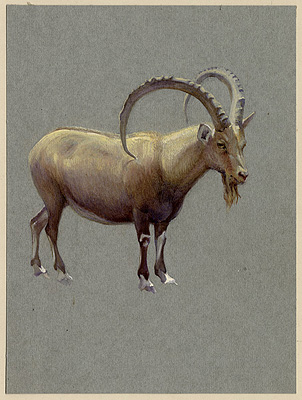
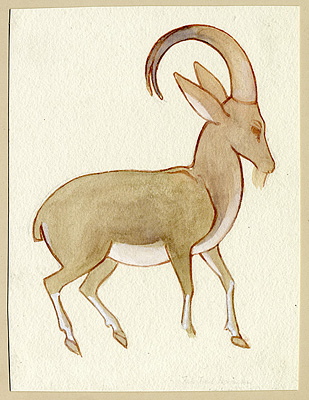 Carter MSS. vii.1.10.1
Carter MSS. vii.1.10.1
watercolour, 12.3 by 16.5 cm
Previous reproductions: ILN Christmas 1944, fig. on 31 [lower right];
Malek, J. The Treasures of Tutankhamun (2006), fig. on 25 [upper left].
Carter MSS. vii.1.10.2
watercolour, 15 by 19.8 cm
Location and dating: not known
Previous reproductions: ILN Christmas 1944, fig. on 31 [lower left].
Nubian Ibex, Capra nubiana
Although it was apparently relatively common in Ancient Egypt along the
cliffs of the Nile Valley and in the mountains of the Sinai and Eastern
Deserts where there was water, this species has probably become extinct
in North-eastern Africa during the last 40 years or so, although many
depictions of it in rock art and tombs and on pots can still be seen.
The Nubian Ibex is smaller than other ibexes and sandy-brown in colour with
light hindquarters, almost white underparts and black muzzle, chin and most
of the front of its legs. Males and older females are bearded. Its
outstanding feature is, however, its long, semi-circular horns which,
in males, can reach 120 cm in length with up to 36 transverse bosses along
the upper curves. Captive breeding of this species may have taken place
during the Old Kingdom, as indicated in the relief of a stall-fed female
with young in the 5th Dynasty Mastaba of Ti, but this has still to be
proved.
Carter's painting of the actual Nubian Ibex catches many of the important
features but makes the legs too short and the horns too wide-open. His copy
of a tomb painting of this species is, however, much more realistic. (John
Wyatt)
|
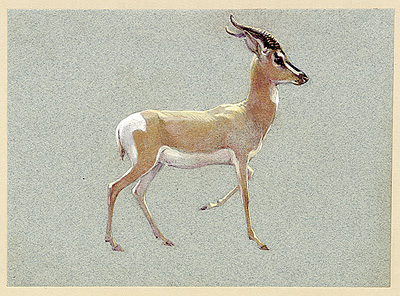 Carter MSS. vii.1.11
Carter MSS. vii.1.11
watercolour, 17.8 by 12.8 cm
Location and dating: not known
Previous reproductions: none.
Dorcas Gazelle, Gazella dorcas
Dorcas Gazelles were among the most common and frequently depicted wild
animals in Predynastic and Pharaonic times. They still occur in rapidly
decreasing numbers in some of the vegetated desert areas of modern Egypt,
especially the southern part of the Eastern Desert, but have already
disappeared from many more suitable habitats such as the Mediterranean
littoral. It is one of the smallest and most dainty-looking gazelles and
is reddish-brown in colour with white throat, chest, belly and rump and a
dark side-stripe. Its facial markings are distinct as are its strongly
annulated, semi-lyrate horns which curve backwards and then upwards,
particularly on the male. (John Wyatt)
|
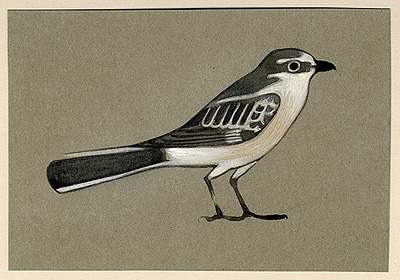
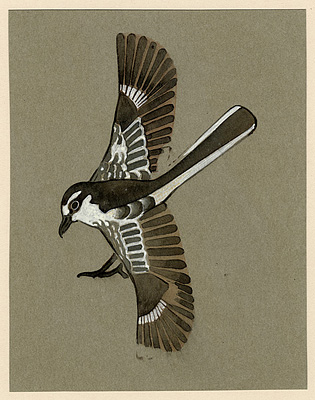 Carter MSS. vii.1.12.1
Carter MSS. vii.1.12.1
watercolour, 11.8 by 8 cm
Location and dating: tomb 3 of Khnumhotep III (or II according to
some authors) at Beni Hasan, temp. Amenemhet II to Sesostris II (Dyn. 12)
Topographical Bibliography: iv.147 (13)
Previous reproductions: ILN Christmas 1944, fig. on 32 [bottom middle].
Carter MSS. vii.1.12.2
watercolour, 11.4 by 14.6 cm
Location and dating: tomb 3 of Khnumhotep III (or II according to some
authors) at Beni Hasan, temp. Amenemhet II to Sesostris II (Dyn. 12)
Topographical Bibliography: iv.147 (13)
Previous reproductions: none.
Masked Shrike, Lanius nubicus
Similarly to the Red-Backed Shrike, the Masked Shrike is rarely attested in
Egyptian art. Only six possible depictions of the bird coming from three
tombs have been identified so far. A single Shrike occurs together with other avian
species in the 11th Dynasty tomb of Baket III at Beni Hasan, and four of
them are shown perched on or flying around acacia trees in the 12th Dynasty
tomb of Khnumhotep III at the same location. The Masked Shrike breeds in
parts of south-eastern Europe and winters both in the latter and in
north-eastern and sub-Saharan Africa north of the equator. It is mainly a
passage migrant to Egypt but a few birds also winter in the Upper Nile
Valley. (Jiří Janák and John Wyatt)
Both copies come from the tomb of Khnumhotep III at Beni Hasan. The reddish
flanks and positive white wing-bar have not been shown strongly enough but
the bird is clearly a Shrike because of the bill which also rules out one
possible confusion species, the African Pied Wagtail, Motacilla
aguimp. No other possible
Shrikes have this colour pattern. (John Wyatt)
|
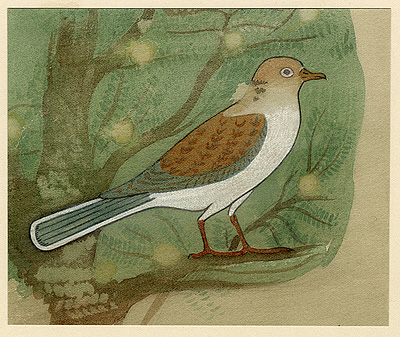 Carter MSS. vii.1.13
Carter MSS. vii.1.13
watercolour, 14.3 by 11.8 cm
Location and dating: tomb 3 of Khnumhotep III (or II according to some authors)
at Beni Hasan, temp. Amenemhet II to Sesostris II (Dyn. 12)
Topographical Bibliography: iv.147 (13)
Previous reproductions: ILN Christmas 1944, fig. on 34 [bottom right].
European Turtle-dove, Streptopelia turtur
The European Turtle-Dove, Streptopelia turtur rufescens (Western
Desert) and Streptopelia turtur isabellina (Nile Valley) are breeding
residents while Streptopelia turtur turtur and Streptopelia turtur
arenicola are the main migratory races. Representations of the European
Turtle-dove are frequently attested from ancient Egypt, since this bird has
always been a valued food article there. These birds thus appear among other
avian species in nature scenes (e.g. in the tomb of Khnumhotep III at Beni
Hasan) or among food offerings. The European Turtle-dove is still very
widely distributed in Europe, the northern Middle East and in Africa north
of the Sahara. (Jiří Janák and John Wyatt)
A somewhat artistic representation but clearly a Turtle Dove from the neck
markings. (John Wyatt)
|
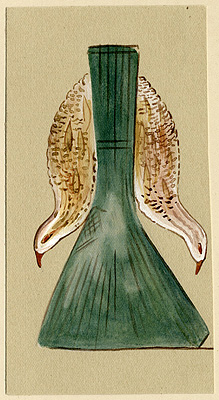
Carter MSS. vii.1.14.2
watercolour, 6.8 by 12.9 cm
Location and dating: not known
Previous reproductions: none.
Common Quail, Coturnix coturnix coturnix
Depictions of the Common Quail are frequently attested in ancient Egyptian
sources, both as the hieroglyphic signs w (G 43 of Gardiner's sign-list)
and in Egyptian art where they appear in their natural environment (e.g. in
grain fields during the harvest season) or among food-offerings. Since
ancient times, migrating Quails have been caught using nets or in fields
during the harvest. Such events are depicted in several Old and Middle
Kingdom tombs such as those at Saqqara and Beni Hasan. Nowadays, the Common
Quail is a scarce local breeding resident of the Delta and the Valley;
it is common countrywide during passage periods. (Jiří Janák and John Wyatt)
The painting is artistic and lacks the strong head and throat markings of
the Quail but there is nothing else it can reasonably be.
(John Wyatt)
|
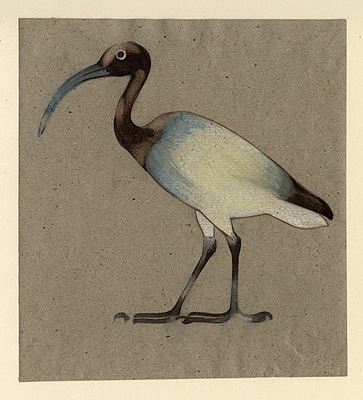 Carter MSS. vii.1.15
Carter MSS. vii.1.15
watercolour, 16.2 by 17.9 cm
Location and dating: tomb 3 of Khnumhotep III (or II according to
some authors) at Beni Hasan, temp. Amenemhet II to Sesostris II (Dyn. 12)
Topographical Bibliography: iv.147 (14)
Previous reproductions: ILN Christmas 1944, fig. on 32 [bottom right].
African Sacred Ibis, Therskiornis aethiopicus
The presence of the Sacred Ibis which counts among Egypt's most
iconic birds, is well attested from the Old Kingdom until the very end of
pharaonic history. The Sacred Ibis is probably associated with the moon god
Thoth, the god of writing and scribes, because its head and curved bill resemble
either the new moon and/or a hand holding a scribe's pen. Depictions of this bird frequently occur both
as hieroglyphs (often very elaborate and accurate) and in Egyptian art (for
example in marshland scenes). Due to the connection with Thoth, representations
of the Sacred Ibis survived in a multitude of occurrences and forms (reliefs,
statuettes, amulets). In the Late and Graeco-Roman Periods when animal cults
were very popular in Egypt, large cemeteries for such animals (including
Ibises) were widespread (for example in Abydos, Tuna el-Gebel, Saqqara).
Dead Ibises were wrapped in linen bandages, some of them with figures of
Thoth attached, and usually buried in ceramic pots. Although the Sacred Ibis
was a common breeding resident in ancient Egypt and was probably also farmed
to produce sufficient numbers for mummification, it became extinct as a
breeding species before 1850 and is now only an occasional vagrant to the
south. (Jiří Janák and John Wyatt)
A good copy of an undoubted juvenile Sacred Ibis. An adult would be blacker,
where this bird is shown as being brown, and have a bushier tail. (John Wyatt)
|
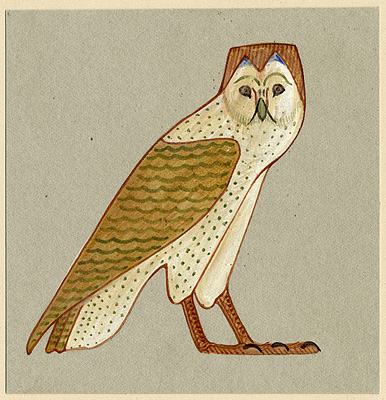 Carter MSS. vii.1.16
Carter MSS. vii.1.16
watercolour, 9.8 by 10.1 cm
Location and dating: not known
Previous reproductions: Griffith, F. Ll. A Collection of
Hieroglyphs (1898), 20 pl. ii [7]; ILN Christmas 1944, fig. on 32 [bottom left];
Malek, J. The Treasures of Ancient Egypt (2010), fig. on 17 [lower].
Barn Owl, Tyto alba alba
Representations of an Owl, most probably the Barn Owl, as a hieroglyph,
where it represents the m sign (G 17 of Gardiner's sign-list),
are very common but depictions in art are very rare with only three
examples, all from the New Kingdom, known. Since this bird
cannot move its eyes which are fixed in the sockets, its entire head
must move towards the expected object or view. The ancient Egyptians
depicted the Barn Owl in an unusual way, en face, most
probably to show its characteristic facial features
of the bird. An erroneous feature, 'ears', was however usually included.
A unique representation of this bird in profile, but excluding 'ears',
comes from the 18th Dynasty tomb of Neferhotep (TT A. 5) at Thebes. In several Ptolemaic
temples, the Barn Owl is shown (together with the Sacred Ibis, the Egyptian
Vulture and the Northern Bald Ibis) in association with the so-called
Vogellauf ritual. Moreover, there are also various attestations
of mummies of this bird from the Late and Ptolemaic Periods. At that time,
the hieroglyph was increasingly shown without ears. In modern Egypt, the
Barn Owl is a fairly common but local breeding resident along the Nile
Valley and probably also in Sinai. (Jiří Janák and John Wyatt)
The Barn Owl, Tyto alba, could be the species being depicted. However, Barn Owls do
not have ears and even the Egyptian race is not as heavily spotted as shown.
The African Grass Owl, Tyto capensis, cannot therefore be eliminated
but that too does not have ears. At least four species of eared owl do
nevertheless occur in Egypt as resident breeders or summer or winter
visitors so perhaps this hieroglyph is an amalgam of several species. There
may, however, be another explanation. Both Barn and Grass Owls have
almost triangular white indentations above their eyes which in certain
lights look dark through being in shadow. Were these mis-represented as 'ears'?
(John Wyatt)
|
Go to Griffith Institute Archive watercolour collections.
| |
